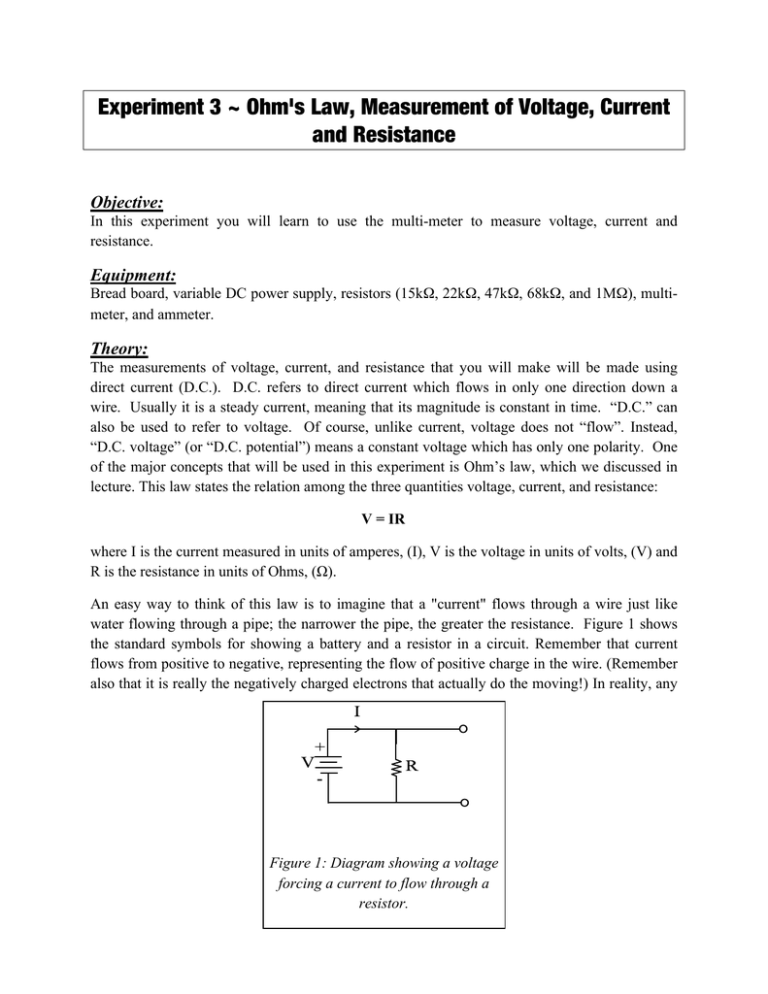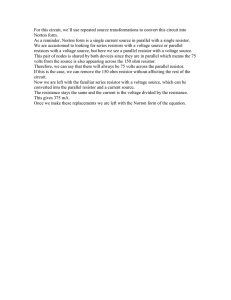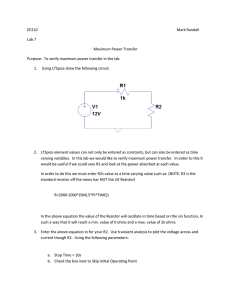Ohm's Law Experiment: Voltage, Current, Resistance
advertisement

Experiment 3 ~ Ohm's Law, Measurement of Voltage, Current and Resistance Objective: In this experiment you will learn to use the multi-meter to measure voltage, current and resistance. Equipment: Bread board, variable DC power supply, resistors (15kΩ, 22kΩ, 47kΩ, 68kΩ, and 1MΩ), multimeter, and ammeter. Theory: The measurements of voltage, current, and resistance that you will make will be made using direct current (D.C.). D.C. refers to direct current which flows in only one direction down a wire. Usually it is a steady current, meaning that its magnitude is constant in time. “D.C.” can also be used to refer to voltage. Of course, unlike current, voltage does not “flow”. Instead, “D.C. voltage” (or “D.C. potential”) means a constant voltage which has only one polarity. One of the major concepts that will be used in this experiment is Ohm’s law, which we discussed in lecture. This law states the relation among the three quantities voltage, current, and resistance: V = IR where I is the current measured in units of amperes, (I), V is the voltage in units of volts, (V) and R is the resistance in units of Ohms, (Ω). An easy way to think of this law is to imagine that a "current" flows through a wire just like water flowing through a pipe; the narrower the pipe, the greater the resistance. Figure 1 shows the standard symbols for showing a battery and a resistor in a circuit. Remember that current flows from positive to negative, representing the flow of positive charge in the wire. (Remember also that it is really the negatively charged electrons that actually do the moving!) In reality, any Figure 1: Diagram showing a voltage forcing a current to flow through a resistor. circuit element (like a light bulb) can act as a resistor. For experiments and for building circuits, small resistors of known resistance can be added to the circuit. The Experiment Part 1: 1. Look at several different resistors, which will be passed out to you. 2. There are two ways to find out what the value of any given resistor is. a. You can measure the resistance using the function marked Ω on your multi-meter. (kΩ means kilo-ohms or ohms x 1000. MΩ means mega-ohms or ohms x 1,000,000.) Measure several different resistors with your ohmmeter and record the values in Data Table 1. b. The second way to determine the value of a resistor is to read the color code (see the previous page for the key to the code). Determine the resistance values from the color code and record these values next to your measured values. 3. For each resistor, calculate the percent difference between the resistance measured with the ohmmeter and the resistance calculated from the color code chart. Enter the data in Data Table 1. Part 1 – Analysis: Data Table 1 Resistor (Colors) Resistor 1 ( ) Resistor 1 ( ) Resistor 1 ( ) Resistor 1 ( ) Resistor 1 ( ) Measured Resistance (Ω) Calculations Resistance from color code chart (Ω) % diff. Part 2: 1. Connect the circuit as shown by the diagram in Fig. 2. Use the variable power supply and a 15KΩ resistor. Adjust the power supply voltage to 5 volts. Figure 2A Figure 2B Figure 2 - A: Circuit diagrams, B: Actual connections for the circuit shown on the left 2. Use the multi-meter to measure the voltage across the resistor (VR). 3. Use the ammeter to measure the current through the resistor (I). 4. Record your measurements of voltage and current in Data Table 2. 5. Repeat steps 2 through 4 for 10 different values of voltage, in steps of 1V. Record all measurements in your table. Part 2 – Analysis: 1. Enter the data from Table 2 into Excel, and plot it with current on the x-axis and voltage on the y-axis. As you may have noticed, Ohm's law is an equation in the form of a straight line: V = RI → y = mx + b In the case of Ohm's law, we have (ideally) the slope m = R and the y-intercept b = 0. Fit a straight line to the data. What value do you get for the resistance? (Important: in order to get your slope (R) in units of Ohms, you must have current in units of Amperes and voltage in units of Volts. If you originally recorded your current data in units of milliamps, or some other unit, be careful to convert back to Amps!) 2. Measure the resistor you used with the ohmmeter. Is the value similar to the value you calculated from the slope of your line? Calculate the percent difference between the two values of R. Data Table 2 Power Supply Voltage, V Voltage Across Resistor, VR, (V) (V) Trendline equation (y=): __________________ Slope = _____________ R from color code chart = __________ Percent difference of Slope and R= ________________ Current, I (A) Questions: 1. In Part 1 of the experiment, are the measured values of resistance within the tolerance given by the resistor's color code? (Look at the percent difference.) Explain. 2. In Part 2 of the experiment, was the value of the resistance you obtained from your graph within the tolerance given by the resistor’s color code? Explain. 3. List some possible sources of error that might have affected your measurements in Part 2 of the experiment. 4. Is a plot of current vs. voltage ALWAYS a straight line? Explain why or why not. 5. Sometimes, people might plot I on the y-axis and V on the x-axis. (In this case, the slope will be 1/R.) Why might a scientist want to plot the data that way?






